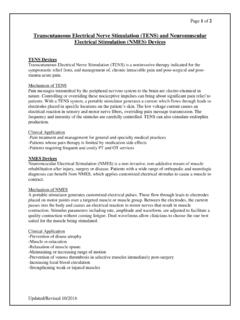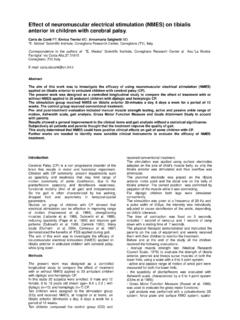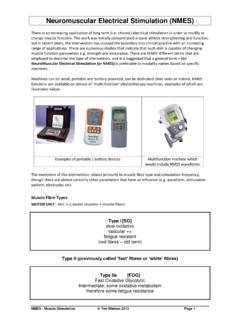Transcription of Medicare Coverage Issues Manual
1 Medicare Department of Health &Human Services (DHHS) Coverage Issues Manual Centers for Medicare & Medicaid Services (CMS) Transmittal 160 Date: NOVEMBER 1, 2002 CHANGE REQUEST 2314 HEADER SECTION NUMBERS PAGES TO INSERT PAGES TO DELETE Table of Contents 2 pp 2 pp 35-77 35-79 3 pp 2 pp NEW/REVISED MATERIAL--EFFECTIVE DATE: April 1, 2003 IMPLEMENTATION DATE: April 1, 2003 Section 35-77 neuromuscular electrical stimulation (NMES) for Use by Spinal Cord Injured (SCI) Patients for Walking, new section on NMES. There are two broad categories of NMES. One type stimulates the muscle when the patient is in a resting state to treat patients with muscle atrophy.
2 A second type is used to enhance functional activity in neurologically impaired patients. These devices use electrical impulses to activate paralyzed or weak muscles in precise sequence and have been utilized to provide SCI patients with the ability to walk. Based on the evidence that we have reviewed, we are issuing a positive national Coverage determination for the use of NMES for walking, but we will maintain the existing national noncoverage policy for the treatment of disuse atrophy in SCI patients. This revision is a national Coverage decision (NCD). The NCDs are binding on all carriers, intermediaries, peer review organization, health maintenance organizations, competitive medical plans, and health care prepayment plans. Under 42 CFR (b), an NCD that expands Coverage is also binding on a Medicare +Choice Organization.
3 In addition, an administrative law judge may not reivew an NCD. (See 1869 (f)(1)(A)( i ) of the Social Security Act.) These instructions should be implemented within your current operating budget. DISCLAIMER: The revision date and transmittal number only apply to the redlined material. All other material was previously published in the Manual and is only being reprinted. CMS-Pub. 6 Coverage Issues Nonselective (Random) Transfusions and Living-Related Donor Specific Transfusions (DST) in Kidney Transplantation 35-71 Electrotherapy for Treatment of Facial Nerve Paralysis (Bell's Palsy) - Not Covered 35-72 Injection Sclerotherapy for Esophageal Variceal Bleeding 35-73 External Counterpulsation (ECP) for Severe Angina 35-74 Intraoperative Ventricular Mapping 35-75 neuromuscular electrical stimulation (NMES) 35-77 Diagnostic Endocardial electrical stimulation (Pacing)
4 35-78 Anesthesia in Cardiac Pacemaker Surgery 35-79 Treatment of Kidney Stones 35-81 Pancreas Transplants 35-82 24-Hour Ambulatory Esophageal pH Monitoring 35-83 Stereotactic Cingulotomy as a Means of Psychosurgery - Not Covered 35-84 Implantation of Automatic Defibrillators 35-85 Gastric Balloon for Treatment of Obesity - Not Covered 35-86 Heart Transplants 35-87 Extracorporeal Photopheresis 35-88 Speech Pathology Services for the Treatment of Dysphagia 35-89 Extracorporeal Immunoadsorption (ECI) Using Protein A Columns for the Treatment of Patients With Idiopathic Thrombocytopenia Purpura (ITP) Failing Other Treatments 35-90 Laparoscopic Cholecystectomy 35-91 Transcendental Meditation--Not Covered 35-92 Lung Volume Reduction Surgery (Reduction Pneumoplasty, Also Called Lung Shaving or Lung Contouring) Unilateral or Bilateral By Open or Thoracoscopic Approach for Treatment of Emphysema and Chronic Obstructive Pulmonary Disease - Not Covered 35-93 Transmyocardial Revascularization With Laser - Not Covered 35-94 Partial Ventriculectomy (Also known as Ventricular Reduction, Ventricular 35-95 Remodeling, or Heart Volume Reduction Surgery) - Not Covered Cryosurgery of Prostate - Not Covered 35-96 Vertebral Axial Decompression (VAX-D)
5 - Not Covered 35-97 Electronicstimulation in the Treatment of Wounds 35-98 Abortion 35-99 Photodynamic Therapy 35-100 Treatment of Actinic Keratosis 35-101 electrical stimulation for the Treatment of Wounds 35-102 Supplies - Drugs L-Dopa 45-1 Insulin Syringe 45-3 Vitamin B-l2 Injections to Strengthen Tendons, Ligaments, Etc., of the Foot - Not Covered 45-4 Hydrophilic Contact Lens for Corneal Bandage 45-7 Laetrile and Related Substances - Not Covered 45-10 Autogenous Epidural Blood Graft 45-11 Porcine Skin and Gradient Pressure Dressing 45-12 Physician's Office Within an Institution - Coverage of Services and Supplies Incident to a Physician's Services 45-15 Certain Drugs Distributed by the National Cancer Institute 45-16 Transfer Factor for Treatment of Multiple Sclerosis Granulocyte Transfusions 45-18 Transcutaneous electrical Nerve stimulation (TENS) for Acute Post-Operative Pain 45-19 Rev.
6 160 Coverage Issues Ethylenediamine-Tetra-Acetic (EDTA) Chelation Therapy for Treatment of Atherosclerosis 45-20 Scalp Hypothermia During Chemotherapy to Prevent Hair Loss 45-21 Lymphocyte Immune Globulin, Anti-Thymocyte Globulin (Equine) 45-22 Dimethyl Sulfoxide (DMSO) 45-23 Anti-Inhibitor Coagulant Complex (AICC) 45-24 Supplies Used in the Delivery of Transcutaneous electrical Nerve stimulation (TENS) and neuromuscular electrical stimulation (NMES) 45-25 Platelet-Derived Wound Healing Formula 45-26 Blood Transfusions 45-27 Antigens Prepared for Sublingual Administration 45-28 Intravenous Iron Therapy 45-29 Photosensitive Drugs 45-30 Intravenous Immune Globulin for the Treatment of Autoimmune Mucocutaneous Blistering Diseases 45-31 Diagnostic Services Cardiac Pacemaker Evaluation Services 50-1 Cytotoxic Food Tests - Not Covered 50-2 His Bundle Study 50-3 Gravlee Jet Washer 50-4 Thermography 50-5 Plethysmography
7 50-6 Ultrasound Diagnostic Procedures 50-7 Consultation Services Rendered by a Podiatrist in a Skilled Nursing Facility 50-8 Gastrophotography 50-9 Vabra Aspirator 50-10 Computerized Tomography 50-12 Magnetic Resonance Imaging 50-13 Magnetic Resonance Angiography 50-14 Electrocardiographic Services 50-15 Hemorheograph 50-16 Laboratory Tests - CRD Patients 50-17 Electron Microscope 50-18 Pronouncement of Death 50-19 Diagnostic Pap Smears 50-20 Screening Pap Smears and Pelvic Examinations for Early Detection of Cervical Cancer or Vaginal Cancer Mammograms 50-21 Challenge Ingestion Food Testing 50-22 Histocompatibility Testing 50-23 Hair Analysis 50-24 Esophageal Manometry 50-25 Dental Examination Prior to Kidney Transplantation 50-26 Xenon Scan 50-27 Hospital and Skilled Nursing Facility Admission Diagnostic Procedures 50-28 Cytogenetic Studies 50-29 Nuclear Radiology Procedure 50-30 Evoked
8 Response Tests 50-31 Percutaneous Transluminal Angioplasty (PTA) 50-32 Uroflowmetric Evaluations 50-33 Obsolete or Unreliable Diagnostic Tests 50-34 Sweat Test 50-35 Positron Emission Transverse Tomography (PET or PETT) Scans 50-36 Noninvasive Tests of Carotid Function 50-37 Rev. 16011-02 Coverage Issues - MEDICAL PROCEDURES 35-77 During diastole the three sets of air cuffs are inflated sequentially (distal to proximal) compressing the vascular beds within the muscles of the calves, lower thighs and upper thighs. This action results in an increase in diastolic pressure, generation of retrograde arterial blood flow and an increase in venous return. The cuffs are deflated simultaneously just prior to systole, which produces a rapid drop in vascular impedance, a decrease in ventricular workload and an increase in cardiac output. The augmented diastolic pressure and retrograde aortic flow appear to improve myocardial perfusion, while systolic unloading appears to reduce cardiac workload and oxygen requirements.
9 The increased venous return coupled with enhanced systolic flow appears to increase cardiac output. As a result of this treatment, most patients experience increased time until onset of ischemia, increased exercise tolerance, and a reduction in the number and severity of anginal episodes. Evidence was presented that this effect lasted well beyond the immediate post-treatment phase, with patients symptom-free for several months to two years. This procedure must be done under direct supervision of a physician. 35-75 INTRAOPERATIVE VENTRICULAR MAPPING--(Effective for services rendered on or after 10/29/84.) Intraoperative ventricular mapping is the technique of recording cardiac electrical activity directly from the heart. The recording sites are usually identified from an anatomical grid and may consist of epicardial, intramural, and endocardial sites.
10 A probe with electrodes is used to explore these surfaces and generate a map that displays the sequence of electrical activation. This information is used by the surgeon to locate precisely the site of an operative intervention. The intraoperative ventricular mapping procedure is covered under Medicare only for the uses and medical conditions described below: o Localize accessory pathways associated with the Wolff-Parkinson-White (WPW) and other preexcitation syndromes; o Map the sequence of atrial and ventricular activation for drug-resistant supraventricular tachycardias; o Delineate the anatomical course of His bundle and/or bundle branches during corrective cardiac surgery for congenital heart diseases; and o Direct the surgical treatment of patients with refractory ventricular tachyarrhythmias. 35-77 neuromuscular electrical stimulation (NMES) neuromuscular electrical stimulation (NMES) involves the use of a device that transmits an electrical impulse to activate muscle groups by way of electrodes.



















